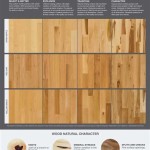Can I Install Laminate Flooring Over Wood Floor? A Comprehensive Guide
The question of whether laminate flooring can be installed over existing wood flooring is a common one for homeowners considering a flooring upgrade. The answer is generally yes, but several factors must be carefully evaluated to ensure a successful and lasting installation. This article will delve into these considerations, outlining the necessary preparation steps and potential challenges to address before embarking on such a project.
The primary benefit of installing laminate over wood is cost-effectiveness. Bypassing the removal of the existing wood floor significantly reduces labor costs and disposal fees. Furthermore, the existing wood subfloor can provide a stable and level base for the laminate, contributing to its longevity and preventing common issues such as squeaking or unevenness.
However, simply laying laminate over wood without proper assessment and preparation can lead to significant problems down the line. Moisture issues, uneven surfaces, and instability in the existing wood flooring can all compromise the integrity of the new laminate installation. Understanding these potential pitfalls and taking proactive measures to mitigate them is crucial for achieving a satisfactory result.
Key Point 1: Assessing the Existing Wood Floor
Before proceeding with laminate installation, a thorough assessment of the existing wood floor is paramount. This assessment should focus on several crucial aspects:
Moisture Content: High moisture levels in the wood floor are a major concern. Moisture can lead to mold growth, warping of the wood, and ultimately, damage to the laminate flooring. A moisture meter should be used to measure the moisture content of the wood in several areas of the room, particularly along exterior walls and in areas prone to spills. Acceptable moisture levels typically range between 6% and 12%, depending on the type of wood and the local climate. If moisture levels exceed these thresholds, the source of the moisture must be identified and addressed before proceeding. This may involve repairing leaks, improving ventilation, or installing a vapor barrier.
Structural Integrity: The existing wood floor must be structurally sound to provide a stable base for the laminate. Inspect the floor for loose boards, soft spots, or signs of rot. Any damaged or weakened areas must be repaired or replaced before installing the laminate. Walking across the floor should not reveal excessive movement or creaking, as this indicates instability that needs to be corrected. Consider reinforcing the subfloor from below if necessary.
Levelness: Laminate flooring requires a relatively level surface for proper installation. Significant variations in height can cause the laminate planks to buckle or separate over time. Use a long level to identify any high or low spots in the floor. Minor imperfections can often be corrected with a self-leveling compound. However, more significant unevenness may require sanding down high spots or adding shims to low spots. A perfectly level floor is not usually necessary, but variations should be minimized to ensure a smooth and even surface for the laminate.
Existing Finish: While not always necessary, consider the existing finish on the wood floor. A heavily glossed finish might hinder the laminate underlayment's ability to properly grip the surface. In such instances, light sanding or using a bonding primer can be beneficial to improve adhesion.
Ignoring these factors can lead to costly repairs and premature failure of the laminate flooring. A comprehensive assessment ensures that the existing wood floor provides a solid and reliable foundation for the new installation.
Key Point 2: Preparing the Wood Floor for Laminate Installation
Once the assessment is complete and any necessary repairs have been made, the next step is to prepare the wood floor for the laminate installation. This involves cleaning, smoothing, and potentially adding a moisture barrier.
Cleaning: Thoroughly clean the existing wood floor to remove any dirt, dust, debris, or old adhesive residue. Sweep, vacuum, and then damp-mop the floor with a suitable cleaning solution. Ensure the floor is completely dry before proceeding to the next step.
Smoothing: Address any minor imperfections or unevenness in the floor. Small cracks or gaps can be filled with wood filler. High spots can be sanded down using a sanding block or orbital sander. Ensure that any repairs are flush with the surrounding surface.
Installing a Moisture Barrier: A moisture barrier is crucial, especially if the wood floor is located on a concrete slab or in a humid environment. This barrier prevents moisture from seeping up from the subfloor and damaging the laminate. A 6-mil polyethylene film is a common and effective moisture barrier. Overlap the seams by at least 6 inches and tape them securely with waterproof tape.
Underlayment Installation: An underlayment provides cushioning, sound insulation, and additional moisture protection. It is typically installed directly over the moisture barrier. Choose an underlayment specifically designed for laminate flooring. Ensure the underlayment is properly aligned and secured according to the manufacturer's instructions.
Proper preparation of the wood floor is essential for a successful laminate installation. A clean, smooth, and moisture-protected surface will ensure that the laminate flooring lies flat, stays in place, and lasts for many years.
Key Point 3: Addressing Potential Challenges and Considerations
While installing laminate flooring over wood can be a cost-effective option, several potential challenges and considerations should be addressed proactively:
Door Clearance: Adding laminate flooring and underlayment will raise the floor height, potentially affecting door clearance. Check the clearance under doors and trim them if necessary to ensure they can open and close freely without rubbing against the new flooring.
Transition Strips: Transition strips are used to seamlessly connect the laminate flooring to other types of flooring in adjacent rooms. Choose transition strips that match the laminate and provide a smooth transition in height. Install the transition strips securely according to the manufacturer's instructions.
Expansion Gaps: Laminate flooring expands and contracts with changes in temperature and humidity. Leave an expansion gap of approximately ¼ to ½ inch around the perimeter of the room and around any vertical obstructions, such as pipes or door frames. Cover the expansion gap with baseboards or molding to conceal it from view.
Installation Techniques: While laminate flooring is typically designed for DIY installation, following the manufacturer's instructions carefully is crucial. Use the correct tools and techniques to ensure that the planks are properly aligned and interlocked. Avoid forcing the planks together, as this can damage the locking mechanism.
Subfloor Movement: Even with thorough preparation, some movement in the original wood subfloor may still transfer to the laminate. Utilizing a high-quality, thick underlayment can help mitigate this effect. Also, understanding the framing structure beneath the wood floor can inform heavier furniture placement to avoid exacerbating any existing weak points.
Fastener Considerations: If using fasteners to secure the underlayment or transitions, understanding the location of plumbing and electrical within the existing floor is important. This prevents accidental damage to underlying house systems.
Addressing these challenges and considerations proactively will help ensure a smooth and successful laminate installation. By taking the time to properly assess the existing wood floor, prepare the surface, and address potential issues, homeowners can enjoy a beautiful and durable new floor for many years to come.
In conclusion, installing laminate flooring over wood flooring is feasible, but meticulous planning and preparation are vital. A comprehensive understanding of the existing wood floor's condition and proactive measures to address any potential problems are critical to a successful and long-lasting installation. Proper assessment, preparation, and attention to detail will contribute to a satisfying outcome.

Installing Luxury Vinyl Floors Over Engineered Hardwood Honey Built Home

When Can I Install A New Floor Over An Old

Common Mistakes When Laying Laminate Flooring Next Day Floors

Can You Install Luxury Vinyl Over Hardwood

Can You Install Laminate Floor Over Hardwood How To Guide

Installing Luxury Vinyl Floors Over Engineered Hardwood Honey Built Home

Laying New Wood Flooring Over Original Uneven Floorboards Le Arthur Wells

How To Install Laminate Flooring Forbes Home

Flooring Installation Can I Install Over Existing Floor

Can You Put Laminate Flooring Over Tile Twenty Oak
Related Posts








